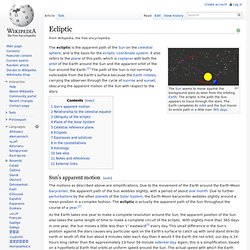

12 star signs (zodiac)
Celestial sphere. In astronomy and navigation, the celestial sphere is an imaginary sphere of arbitrarily large radius, concentric with a particular celestial body.

All objects in the observer's sky can be thought of as projected upon the inside surface of the celestial sphere, as if it were the underside of a dome or a hemispherical screen. The celestial sphere is a practical tool for spherical astronomy, allowing observers to plot positions of objects in the sky when their distances are unknown or unimportant. Introduction[edit] For some objects, this is over-simplified.
Objects which are relatively near to the observer (for instance, the Moon) will seem to change position against the distant celestial sphere if the observer moves far enough, say, from one side of the celestial body to the other. The celestial sphere can be thus be thought of as a kind of astronomical shorthand, and is applied very frequently by astronomers. Celestial coordinate systems[edit] History[edit] Star globe[edit] See also[edit] Celestial coordinate system. In astronomy, a celestial coordinate system is a system for specifying positions of celestial objects: satellites, planets, stars, galaxies, and so on.

Coordinate systems can specify a position in 3-dimensional space, or merely the direction of the object on the celestial sphere, if its distance is not known or not important. Coordinate systems[edit] Horizontal system[edit] The horizontal, or altitude-azimuth, system is based on the position of the observer on Earth, which revolves around its own axis once per sidereal day (23 hours, 56 minutes and 4.091 seconds) in relation to the "fixed" star background. The positioning of a celestial object by the horizontal system varies with time, but is a useful coordinate system for locating and tracking objects for observers on earth. Equatorial system[edit] Equirectangular plot of declination vs right ascension of stars brighter than apparent magnitude 5 relative to the modern constellations, ecliptic and Milky Way (fuzzy band). Notation[edit] or. Ecliptic. The Sun seems to move against the background stars as seen from the orbiting Earth.

The ecliptic is the path the Sun appears to trace through the stars. The Earth completes its orbit and the Sun traces its entire path in a little over 365 days. Sun's apparent motion[edit] As the Earth takes one year to make a complete revolution around the Sun, the apparent position of the Sun also takes the same length of time to make a complete circuit of the ecliptic. With slightly more than 365 days in one year, the Sun moves a little less than 1° eastward[3] every day. Zodiac. The Earth in its orbit around the Sun causes the Sun to appear on the celestial sphere moving over the ecliptic (red), which is tilted with respect to the equator (blue-white).

In both astrology and historical astronomy, the zodiac (Greek: ζῳδιακός, zōidiakos) is a circle of twelve 30° divisions of celestial longitude that are centered upon the ecliptic, the apparent path of the Sun across the celestial sphere over the course of the year. The paths of the Moon and visible planets also remain close to the ecliptic, within the belt of the zodiac, which extends 8-9° north or south of the ecliptic, as measured in celestial latitude.
Because the divisions are regular, they do not correspond exactly to the twelve constellations after which they are named. Historically, these twelve divisions are called signs. Zodiac connects all. Astrology. Greek Astrology. Western Astrologie.